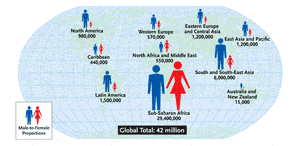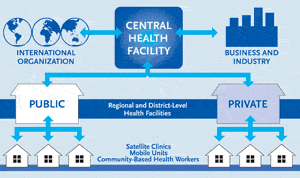Figure 1. Estimated Number of Persons Living with HIV/AIDS, December 2002

There are between 38 and 42 million people worldwide infected with HIV, 95% of whom live in developing countries. HIV/AIDS has killed more than 20 million people worldwide, with approximately 3.1 million deaths reported in 2002 alone. AIDS is the leading cause of death in Africa, where approximately 70% of the worldwide epidemic is concentrated, and the fourth-leading cause of death worldwide.
Source: UNAIDS
There are between 38 and 42 million people worldwide infected with HIV, 95% of whom live in developing countries (see Figure 1). HIV/AIDS has killed more than 20 million people worldwide, with approximately 3.1 million deaths reported in 2002 alone. AIDS is the leading cause of death in Africa, where approximately 70% of the worldwide epidemic is concentrated, and the fourth-leading cause of death worldwide.
“The numbers are beyond comparison,” Dr. Mark Dybul said in opening his December 2004 PRN lecture. “By 2010, there will be 45 million new infections, for a total of 105 million cases of HIV in the world. There will be 25 million orphans by 2020, a number that blows me away every time I hear it. Seventy million deaths are also anticipated by 2020. That’s more than the number of people who died in World War ii, including all civilian and military casualties. The impact on global stability is very real. When we look at Africa, the entire continent could very well implode. Fortunately, there is something we can do.”
In a paper published two years ago in The Lancet, John Stover and his colleagues at The Futures Group International (TFGI), based in Glastonbury, Connecticut, examined the potential effect of an expanded response to the global HIV/AIDS epidemic using mathematical models of HIV transmission (Stover, 2002). In short, it was determined that if the successes achieved in some countries in preventing HIV transmission could be expanded to a global scale by 2005, approximately 29 million new infections could be prevented by 2010. “If we intervened two years ago,” Dr. Dybul said in his review of the TFGI data, “we could have prevented 60% of new infections. This was how the President’s Emergency Plan for AIDS Relief was born. We recognized the need to focus on both treatment and prevention.”
| The U.S. Government Response to the Global HIV/AIDS Epidemic | Top of page |
The U.S. Government has been funding international AIDS programs for many years, initially in the form of contributions from the U.S. Agency for International Development (with funds usually going to UNAIDS, the United Nations AIDS program), international research sponsored by the National Institutes of Health, and additional funding from the U.S. Centers for Disease Control. Under the Bush Administration, in 2001, the U.S. Government co-founded the Global Fund to Fight AIDS, Tuberculosis, and Malaria, in collaboration with United Nations Secretary-General Koffi Annan, in an effort to increase resources to fight three of the world’s most devastating diseases, and to direct resources to areas of greatest need.
In 2002, the U.S. Government announced a $500 million International Mother and Child HIV Prevention Initiative. Through a combination of improving care and drug treatment, it is hoped that this initiative will reach approximately one million women annually and will reduce mother-to-child transmission of HIV by 40% within five years in twelve African countries and the Caribbean.
In 2003, the President’s Emergency Plan for AIDS Relief (PEPFAR) was announced, and in 2004, the International Vaccine Initiative which, Dr. Dybul explained, “is focused on getting everyone in the world working together on the development of safe and effective vaccines against HIV infection.”
| Interventions in the Focus Countries: Treatment | Top of page |
Another aggressive goal of PEPFAR is to provide antiretroviral treatment over the next five years to at least two million people living in focus countries. However, meeting this goal requires far more than providing a consistent supply of essential antiretrovirals, although this is a daunting challenge in itself. It requires addressing complex issues such as the lack of adequate infrastructure, staff, and technical capacity to provide safe, high-quality treatment programs that reach even rural communities. Further, many countries have yet to develop appropriate treatment protocols and policies to ensure safe and adequate drug supply and the equitable distribution of health resources.
Figure 2. The Healthcare Network Model

IPEPFAR plans to scale up treatment availability through what is known as the “network model.” Network models are made up of central medical facilities, district-level hospitals, and local health clinics, supplemented by private facilities. This network concept of public and private health care institutions currently provides the backbone design of healthcare delivery systems, and many of the focus countries—e.g., Nigeria, Uganda, and Haiti—have planned their HIV/AIDS strategies with networked healthcare systems as the foundation.
Within these networks, central medical centers and referral hospitals must have an adequate number of healthcare professionals trained in all aspects of HIV/AIDS clinical and program management. These facilities need to have adequate physical infrastructure, research capabilities, and must be able to effectively link with a series of smaller regional hospitals and district facilities—down to community-level satellite clinics, mobile units, and community based services. To reach rural areas, community-based healthcare workers will deliver essential supplies, including medications, to patients in their communities.
Source: Office of the United States Global AIDS Coordinator
The first strategy outlined in PEPFAR is to rapidly scale up treatment availability through what is known as the “network model.” As explained by Dr. Dybul, network models are made up of central medical facilities, district-level hospitals, and local health clinics, supplemented by private facilities (see Figure 2). This network concept of public and private health care institutions currently provides the backbone design of healthcare delivery systems, and many of the focus countries—e.g., Nigeria, Uganda, and Haiti—have planned their HIV/AIDS strategies with networked healthcare systems as the foundation.
Unfortunately, the current capacity of these existing networked healthcare systems to deliver HIV/AIDS prevention, treatment, and care services is limited, particularly in rural areas. PEPFAR, in accordance with national health and HIV/AIDS strategies and with the intent to build long-term sustainability, aims to strengthen linkages between central facilities and international and private support to build the capacity of different network components and strengthen network-wide linkages in order to more effectively deliver quality HIV/AIDS services to those who need them most.
Within these networks, central medical centers and referral hospitals must have an adequate number of healthcare professionals trained in all aspects of HIV/AIDS clinical and program management. These facilities need to have adequate physical infrastructure, research capabilities, and must be able to effectively link with a series of smaller regional hospitals and district facilities—down to community-level satellite clinics, mobile units, and community based services. To reach rural areas, community-based healthcare workers will deliver essential supplies, including medications, to patients in their communities.
Nurses and community healthcare workers will be trained in routine care, symptom management, and monitoring for treatment adherence, while highly trained doctors—currently in scarce supply in many of the focus countries—will use their expertise in specialized and difficult cases. For example, doctors will periodically visit a community to evaluate patients identified for advanced care by nurses and community healthcare workers.
“Networks such as this are already established in countries like Uganda,” Dr. Dybul commented. “We actually do this in the United States as well.” In Alaska, for example, there are healthcare networks that work with a single central medical center in Anchorage. “The university in Anchorage provides the tertiary care, but the network allows nurses and community health AIDS to provide care to those who need it in some of the most remote tribal communities, some several hundred miles away from the central medical center.”
Beyond scaling up treatment availability through the network model, PEPFAR also aims to build capacity for long-term sustainability of quality HIV/AIDS treatment programs, to advance policy initiatives that support treatment, and—as with the planned prevention work—collect information to monitor and evaluate progress and compliance with PEPFAR strategies and policies.
| References | Top of page |
